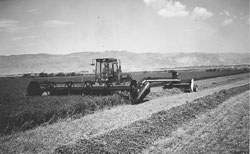
Commercial hay producers Eric and Sue Tuft, Monroe, Utah, devised a system for cutting and windrowing their alfalfa crop that saves at least two trips across the field and has drastically trimmed their fuel use.
With 400 acres of irrigated alfalfa and a four-cut harvest system, Sue says there was a lot of raking to do. Quite often, she drew that duty. With the changes they made, she says, "I'm not out in the field raking hay all summer like I was in the past."
The Tufts own a Ford Versatile 9030 Bi-Directional tractor and had been cutting hay with two 12-ft. mower conditioners - one up front and one behind and to the side. Both mowers dropped a windrow out the center so all windrows were spaced 12 ft. apart.
Last spring, they replaced both mower conditioners with a 25-ft. MacDon 972 draper harvest header up front and a Circle C PT8000 crusher roller conditioner in the back. "We had Circle C build it especially for us, with a hydro-swing tongue on it," Eric notes.
The draper header gives them the option of dropping cut hay in the center or off either end. They can change the drop by flipping a switch in the cab. The hydro-swing tongue on the conditioner allows them to keep it aligned with the swath coming off the header.
By dropping the swath off one end of the draper header and doubling back across the field, they can put 50 ft. of hay into one windrow that can be picked up by their Hesston 4900 big square baler. "It took at least three trips to put that much hay together in the past," Sue says.
In heavy hay, they make one pass using the center drop on the draper head and come back across the field using the end drop so the two passes are only 12 ft. apart. "If we need to put two windrows together later, we can do it with just one pass of the rake," Sue says.
Besides saving time and fuel, Eric says less moving of windrows with a rake means the crop retains more leaves, so they're making better quality hay. The conditioner is moved as needed from behind the tractor to the side.
